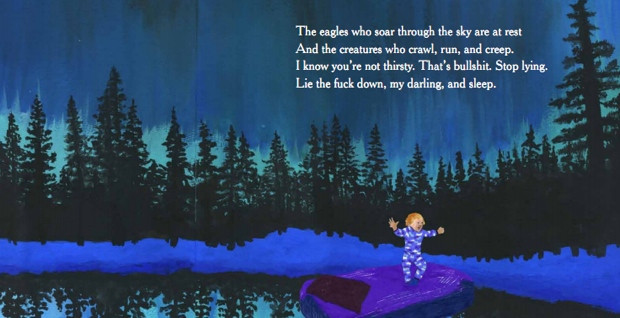The party line on piracy is that it’s bad for business. But what to make of the case of “Go the Fuck to Sleep,” the “children’s book for adults” whose viral-pirate PDF launched the book to the number-one spot on Amazon.com a month before its release?

Something remarkable happened today. A children’s book hit the No. 1 spot on Amazon.com’s best-seller list. And it did so a month before the book is even slated for release.
You may have heard of the book–it’s a best-seller after all. Go the Fuck to Sleep by Adam Mansbach, began its life as a joke Facebook post in June. It was a particularly trying instance of bedtime with his 2-year-old daughter, and Mansbach let off some steam in the form of a humorous status update to his friends: “Look out for my forthcoming children’s book, ‘Go the — to Sleep.’ “
The response from his friends was so fierce that Mansbach decided to make his joke book a real one. Go the Fuck to Sleep, which he bills as a “children’s book for adults,” will hit stores on June 14, published by the Brooklyn press Akashic. If it’s not even due for a month, though, how did a little 32-page book already snag a film option deal with Fox 2000 and, today, reach the pinnacle of online publishing commerce world?
The answer appears to be piracy.
There are many reasons why Go the Fuck to Sleep deserves to be a best-seller, and probably would have attained that status anyway. It’s hilarious. It’s honest. Humor books tend to do well in general, as do parenting books, as do short books. Not to mention it’s the perfect ironic, light-hearted shower gift. Parental exhaustion is by no means an emotion exclusive to Mansbach. The book “just tapped into this nerve,” Ibrahim Ahmad, Akashic senior editor, told The Bay Citizen in its excellent report on the phenomenon.

But all those factors don’t seem to be sufficient to explain why this book has reached the heights that it has, as soon as it has. What seems to set this book apart, hypothesizes The Bay Citizen, is the pirated PDF copy of the book that has gone absolutely viral.
Piracy, any publisher will tell you, is bad. It’s the scourge of the music industry. With the rise of e-reading, booksellers now fear it to a similar degree. Akashic has been fighting the rampant piracy of its best-seller, almost reflexively. As Ahmad told The Bay Citizen: “As the publisher of this book, our responsibilty is to tackle instances of piracy when we become aware of them…That’s just doing a service to our authors, ourselves, book sellers, distributors, to everyone involved in the successful making and promotion of a book.”
But in this particular case, fighting piracy may not be doing a serivce to the book. Piracy, it seems, is what has driven the book’s real-world, money-making, flying-off-the-shelves success. The bootleg copy hasn’t replaced the actual artifact. It has only served as a sort of free advertising. Piracy can hurt publishers, but it can also help them. Call it the double-edged cutlass.
“I’m not sure we’d think it’s a bad thing,” the publicity director of McSweeney’s, Juliet Litman, told The Bay Citizen, of this instance of rampant piracy. May other publishers be so fortunate as to have their booty (profitably) plundered in the same manner as Akashic’s.
The multi-billion-dollar question, though, is this: When does piracy work to a publisher’s benefit, and when does it work to its detriment? If Go the Fuck to Sleep weren’t a children’s book of sorts, would parents be so eager for hard-copy versions? Or if it didn’t have its irresistible illustrations? Books with artwork have a tactile, archival appeal lacking in the latest Grisham potboiler, say.
Neil Gaiman and other prominent authors have gone on the record as essentially supporting the piracy of their own work as a way of building a fanbase. But to what extent did Gaiman’s pre-existing fame act as the necessary ignition to the fire of profitable piracy?
This is fertile ground for research. Publishers should scrutinize the mechanics of e-book piracy, replaying success stories like this one over and over again in slow motion, in an effort to see just what combination of variables caused the pirate’s cutlass to land directly into a giant sack of doubloons.
[Images: Askashic Press]
Follow Fast Company on Twitter. Email David Zax, the author of this post, or follow him on Twitter.

Read More:
How Viral PDFs Of A Naughty Bedtime Book Exploded The Old Publishing Model








